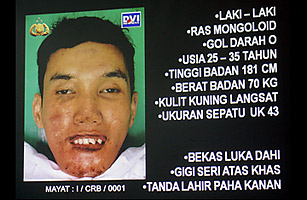
As police investigate the motive behind the latest suicide bombing in Indonesia, the country is once again facing the specter of another wave of attacks by extremists. While recent bombings have targeted individuals rather than large groups, the trend has some analysts worried that the current threat could be harder to stamp out. “This is part of a pattern of do-it-yourself jihad,” explains Sidney Jones, a terrorism expert at the International Crisis Group. “It falls under the ideological precept of jihad fardiya or individual jihad, and I’m afraid we will see more of them.”
It is unclear if Muhammad Syarief, 31, made the bomb himself or had help from outside — police are still investigating his links to other radical groups in the country. Small-scale attacks took place on March 15, with bombs concealed in books sent to four people, including a liberal Muslim activist, the former head of the country’s antiterrorism police unit and a musician. There were no fatalities. The last suicide bombings struck two hotels in Jakarta in July 2009, killing nine people. Observers are concerned that intelligence efforts are failing to keep up with shifting trends and tactics employed by radicals pushing an agenda antagonistic to the country’s secular policies.
The attack during Friday prayers at a police mosque in Cirebon on April 15 injured 30 people and killed the bomber, identified through DNA as Syarief, a known hard-line local activist from the staunchly Islamic area in West Java. The attack was not the first on a mosque in Indonesia, nor was it the first on the police, three of whom were killed by gunfire last September by extremists. It was, however, the first suicide bombing attack on a mosque. Mosques are among the few public places in the country now without heavy security. Since the first Bali bombings in 2002, X-ray machines, scanners and security officers have been posted at the entrances of almost every mall and hotel in Bali, Jakarta and several other major cities.
The Indonesian police have won international praise for their success in dismantling the country’s terrorist networks, like the al-Qaeda-affiliated Jemaah Islamiah. The arrest this month in Pakistan of Umar Patek, wanted for his role in the 2002 Bali bombings, eliminates another key terrorist figure wanted in Indonesia. But the recent bombings may have overcome counterterrorism strategies by resorting to simple tactics such as sending book bombs and assembling crude vest bombs that are harder to detect. “Attacks over the past four or five months are a combination of force of circumstances and ideology,” concludes Jones of the Crisis Group.
The bomber was known to locals for showing up at demonstrations against karaoke bars and rallies against Ahmadiyah, a Muslim sect that has become a target of Indonesian Islamists who see it as deviating from mainstream Islam because it believes that its founder Mirza Ghulam Ahmad, who died in Lahore in 1908, was the Mahdi, a long-awaited messianic figure and a prophet. Mainstream Islam, however, declares that Muhammad was the final prophet and none other can come after him. Syarief had also complained loudly that the local police chief had, among other things, allowed a new karaoke club called Fantasi to open in the area. “Syarief was usually present at rallies organized by the Islamic Defenders Front and the Islamic People’s Forum and other hard-line groups,” says Marzuki Wahid of the Fahmina Institute in Cirebon, a local organization dealing with issues involving Islam, women and human trafficking. “He was a member of a minority movement here that poses a threat to religious harmony in the area.”
“This attack has shaken the confidence of many in Cirebon who thought something like this could not happen here,” says Lies Marcoes-Natsir from the Asia Foundation, which has worked with a number of religious organizations on community policing in the area. Lies was in Cirebon when the incident took place, and she believes intelligence agencies should have picked up on Syarief as a potential threat long before it happened. “We need to know who got to Syarief over the past year and motivated him to move from demonstrating to blowing himself up,” she adds. “The police need to move quickly and find that out before it happens again.”
See “Indonesia’s Artists vs. Muslim Extremists.”
See TIME’s Pictures of the Week.